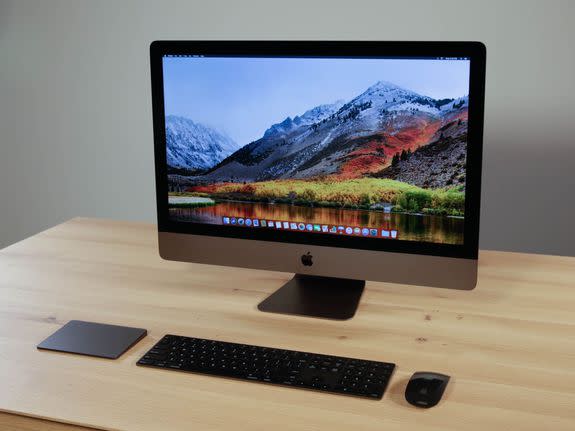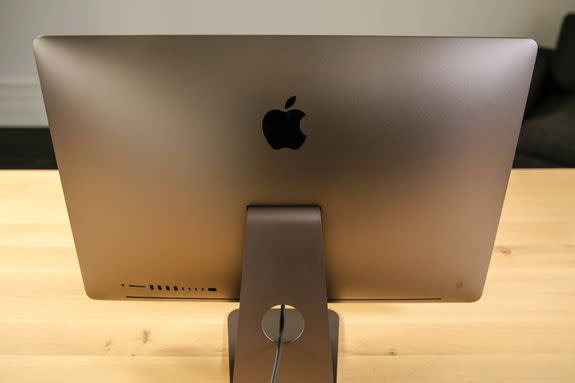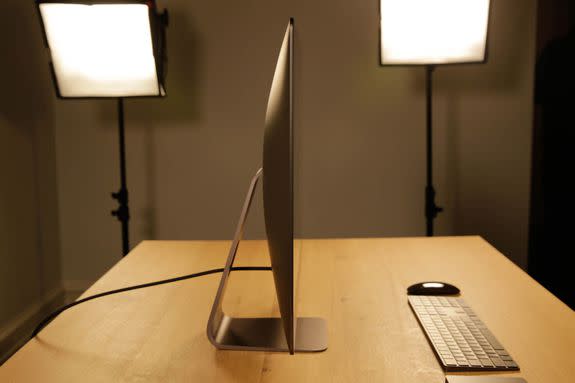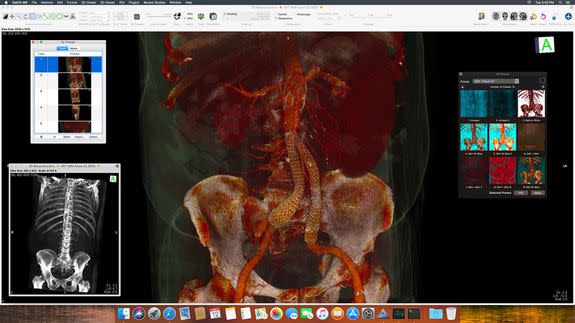This is who the iMac Pro is for

The vast majority of Apple customers will never use an iMac Pro. The monstrously potent machine, billed as the “most powerful Mac ever built” when Apple unveiled it in June, has stratospheric capabilities and a price tag to match, putting it well out of the realm of consideration for your average iPhone user.
But I’d wager all of those people will, at some point, feel the effects of the iMac Pro, which goes on sale Thursday. The machine is tailor-made for creatives who demand the absolute best performance from their computers. Think video editors, special-effects artists, game designers, and architects.
SEE ALSO: Tim Cook promises a new Mac mini will come some day
In other words, when you see a blockbuster movie, play a high-end video game, or walk through a building in the near future, it would be fair to wonder whether what you’re experiencing was designed, at least partially, on one of Apple’s space-gray all-in-one rocket ships.
I got a chance to spend a little time up close with the iMac Pro — in fact, multiple iMac Pros — at an Apple-run demo on Wednesday. What was special about the walk-through, though, was that I met several of the developers and creators who are exactly the iMac Pro’s target market. I talked to visual software mainstays like Adobe, professional software developers who build tools for architects and surgeons, VR creators — as well as Apple itself — to parse who has the iMac Pro on their Christmas lists, and why it was such a game-changer for them.
A new breed of iMac
First, a refresh: The iMac Pro is, for the time being, the most powerful Mac you can buy. It was Apple’s surprise reveal at its Worldwide Developers Conference in June (although execs Phil Schiller and Craig Federighi alluded to Apple’s plans for the iMac line in a wide-ranging discussion about the Mac months earlier). Pro users’ needs have changed radically over the past couple of years, demanding things like support for virtual reality, external graphics processors, and editing raw 4K (and 8K) video. The iMac Pro is a direct response to that.

Image: Pete Pachal/Mashable
The specs are, to borrow a phrase popular with Apple CEO Tim Cook, off the charts: The base model packs an 8-core Intel Xeon W processor, though you can get a chip with as many as 18 cores if you need them. Turbo boost speeds can get as fast as an unheard of 4.5GHz. Base RAM is 32GB, but there are 64GB and 128GB options (the latter being a first for any Mac).
Apple brags that, when it conceived the iMac Pro, the graphics processing unit (GPU) it needed didn’t exist yet. Well, it does now: The Radeon Pro Vega has the kind of specs that make game designers drool: 11 teraflops of performance (at single, 32-bit precision), a next-generation geometry engine, and a new kind of memory that better integrates it into the chip. Yes, it can run Crysis.
The storage is all solid-state Flash — no Fusion drives here — with a minimum of 1TB, though you can go as high as 4TB. And you can get the iMac Pro in any color you want, as long as it’s space gray.

Image: Pete Pachal/Mashable
The 5K Retina display looks truly outstanding. With 5,120 x 2,880 resolution, 500 nits of brightness, and support for 1 billion colors, Apple says it’s the best screen they’ve ever put in an iMac, although it also has the exact same specs as the current 27-inch model. So great they used it twice, I guess.
Apple saved a couple of reveals for Thursday’s launch. In addition to the 8-, 10-, and 18-core chip configurations announced at WWDC, there’s also a 14-core option. And if you prefer to mount your iMac on an articulating arm instead of a stand, you can buy a kit for that. Previous iMacs offered the arm mount as a permanent option, but now it’s user-installable, and you can revert to a regular ol’ stand if you don’t like it.

Image: Pete Pachal/Mashable
Power on paper is one thing, but Apple says it’s made other advancements that enhance the iMac Pro beyond the numbers. One of those is a new chip called the T2, which is separate from the Intel Xeon CPU. The T2 gathers together a bunch of controllers that used to be in separate places on the logic board and puts them all in one custom unit.
You may remember the first generation of this chip, the T1, which debuted on the recent line of TouchBar-brandishing MacBook Pros. The T1 commanded the TouchBar and Touch ID sensor on those laptops, borrowing an essential part of the iPhone’s chipset: the Secure Enclave, which contains and protects the sensitive information… like, you know, fingerprints and stuff.
The iMac Pro’s T2 takes the controller-chip idea and adds to it considerably, housing custom Apple controllers for audio, system management, the solid-state drive, data encryption, and more. That way, housekeeping tasks don’t tax the CPU, leaving all that processing power free when you need to do things like crunch 4K video and VR renders.

Image: Pete Pachal/Mashable
And although the iMac Pro doesn’t have Touch ID, the T2’s Secure Enclave provides the foundation for a new Secure Boot feature. The chip can validate the OS at every step (all the way down to the kernel) and ensure everything is trusted and signed by Apple. Hackers beware.
Another big change from previous iMacs is, because there is no option for a traditional hard drive — that is, a spinning disc that holds all your files — the design frees up enough space for an entirely different cooling system. Not only does it keep the multiple cores on the Xeon chip from turning your machine into space gray slag, but it does so nearly silently. As I bore witness to many feats of computing prowess in Apple’s quiet Tribeca apartment, I never once heard the whir of a cooling fan.
Apple’s most powerful Mac goes on sale Thursday, though if you order a 14- or 18-core model, it won’t ship until late January. The base model starts at $4,999 — a price tag worthy of a spit take for most consumers, but might actually be a decent value when you look at Windows machines with similar specs.
Serious work to do
OK, so the iMac Pro packs serious power. But what can you do with it?
Apple seeded the iMac Pro with several developers to show just that, and I talked to a bunch of them. As I spoke with developer after developer, the thing that came up the most often was the speed of rendering complex graphics. When you work with ultra-high-res 3D graphics, often the program’s workspace shows just a close approximation of imagery that lacks the fine details. When it comes time to see the image in all its glory, you have to press the Render button, and wait.
Depending on the complexity of the graphic and the power of your machine, you might be waiting minutes, hours, or even overnight. But with the iMac Pro, I watched Adobe Dimension render a complex 3D image in less than a minute. Repeatedly I heard developers say the iMac Pro improves rendering time by 2.5x to 5x speed. So something that might have taken all day to render can now be finished before you come back from lunch.

Image: Adobe
One of the most compelling demos was OsiriX MD, a medical imagery program built for radiologists. Taking raw images from a CT scan, the software turned them into a much prettier 3D image of the insides of a specific patient’s body in full color. As we scanned through the body and zoomed in on sections, the designers emphasized the app was rendering in real time, producing full-color rotatable images on the fly from the original CT scans.

Image: Pixmeo
The words “real time” came up a lot, actually. In a demo of what a serious software developer could do with the iMac Pro, I saw it run several different OSes simultaneously: the main macOS, three instances of iOS (for iPhone 8, iPad Pro, and iPhone X) for testing apps, Windows 10 and an older version of macOS within virtual machines, and even compiling some Linux code.
I think there’s some kind of law that whenever Apple releases a Mac with heretofore-unheard-of computing power, there’s a new version of Final Cut that takes advantage of it, and it’s happening again with the iMac Pro. The new Final Cut supports 360 video and can do some pretty cool things with it, but I was most impressed with the fact that it was able to play raw 4K (technically 4.6K) footage shot on a RED camera, and the video was perfectly smooth. Nice.

Image: Servios
My favorite demo, though, was for a VR music program called Electronauts. Designed by an LA-based company called Servios, the app involves strapping on an HTC Vive (the only VR headset that supports macOS) and using the handheld controllers to tap, toss, and explode (you had to be there) various objects to create music. It was a super fun experience, and I was able to make something that resembled a song within minutes.
The iMac gap
As demos go, the guided tour of high-end experiences was masterful, making a very convincing case for the iMac Pro’s existence, and maybe even its value. But it also leads to a natural question: What were all these developers using before?
Those that could get away with it were using “plain” iMacs or MacBook Pros, accepting the compromises that came with the not-quite-up-to-snuff hardware like longer render times or fewer simultaneous actions. But others are probably on Windows machines — either custom jobs or PCs like Microsoft’s own powerful all-in-one aimed at the creative set: the Surface Studio.
SEE ALSO: Apple's most downloaded apps of 2017
Still, one has to wonder how many tasks were slowed down, or worse — never undertaken — because there wasn’t a Mac powerful enough to do them. The Mac didn’t start support for VR until this year, for example, which makes you wonder how many Mac-only creators skipped out on the format during its inception years.
No longer. More than just a machine, the iMac Pro is a declaration: It’s Apple saying to demanding creatives and developers, “We’re here, we’ve got what you need, and we’re committed to you.” Message received loud and clear.
WATCH: This device transforms your ordinary bicycle into an e-bike in seconds

Every editorial product is independently selected by Mashable journalists. If you buy something featured, we may earn an affiliate commission which helps support our journalism.

 Yahoo Finance
Yahoo Finance 